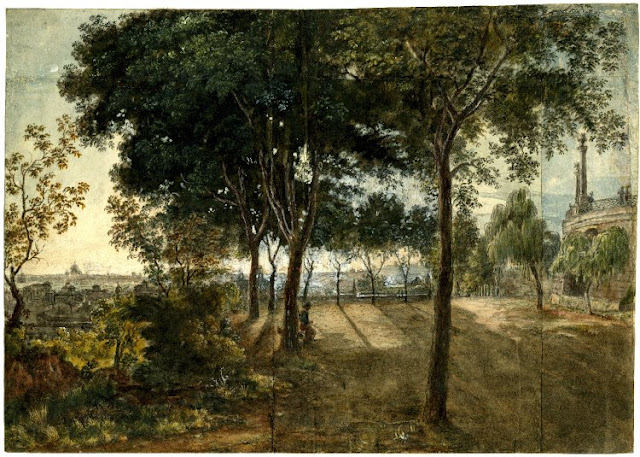 |
| Anonymous Italian artist working in Rome Pan and Daphnis 16th century drawing British Museum |
DAPHNIS – A hero of the Sicilian shepherds, son of Hermes and of a nymph. A beautiful child, he was exposed by his mother in a grove of bay trees, brought up by nymphs and Pan, and taught to play the shepherd's flute. He had plighted his troth to a nymph, but breaking his word, he was punished by her with blindness, or (according to another story) turned into a stone. ... Daphnis consoled himself by inventing pastoral music, or perhaps was the first subject of the genre when other shepherds sang of his misfortunes. In another version he dies when Aphrodite, angry because he will love no one, instills in him a powerful passion to which he refuses to yield. ... Hermes took him up to heaven and created a fountain at the spot where he was taken. At this fountain the Sicilians offered yearly sacrifices.
– from The Dictionary of Classical Mythology, Religion Literature, and Art (London, 1891) and from The Oxford Classical Dictionary, 3rd edition (Oxford, 1996)
 |
| Anonymous Italian artist working in Rome Ganymede and Eagle 16th century drawing British Museum |
 |
| Anonymous Italian artist working in Rome Christ on the Cross 16th century drawing British Museum |
 |
| Anonymous Italian artist working in Rome Descent from the Cross late 16th century drawing British Museum |
 |
| Anonymous Italian artist working in Rome Bearded figure 17th century drawing British Museum |
 |
| Matteo Bonuccelli One of four gilt bronze lions supporting a table 1651 Prado, Madrid replica of one of the marble Medici Lions selected in Rome by Velázquez for copying |
 |
| Matteo Bonuccelli One of four gilt bronze lions supporting a table 1651 Prado. Madrid replica of one of the marble Medici Lions selected in Rome by Velázquez for copying |
 |
| Domenico Gargiulo and Viviano Codazzi Roman Gymnasium ca. 1638 oil on canvas Prado. Madrid |
 |
| Domenico Gargiulo and Viviano Codazzi Roman Amphitheater ca. 1638 oil on canvas Prado, Madrid |
 |
| Domenico Gargiulo and Viviano Codazzi Circus Maximus ca. 1638 oil on canvas Prado, Madrid |
 |
| Domenico Gargiulo and Viviano Codazzi Triumph of Constantine ca. 1636-38 oil on canvas Prado, Madrid |
 |
| Domenico Gargiulo and Viviano Codazzi Triumph of Vespasian ca. 1636-38 oil on canvas Prado, Madrid |
 |
| Anonymous Italian artist Interior courtyard, Rome 17th century drawing British Museum |
 |
| Anonymous German artist St Peter's seen from the Pincio, Rome 1820s drawing British Museum |
"Oh, God! God! God! Every thing I have in my trunks that reminds me of her goes through me like a spear. The silk lining she put in my travelling cap scalds my head. My imagination is horribly vivid about her – I see her – I hear her. There is nothing in the world of sufficient interest to divert me from her a moment. ... I am afraid to write to her – to receive a letter from her – to see her hand writing would break my heart – even to hear of her any how, to see her name written would be more than I can bear. My dear Brown, what am I to do? Where can I look for consolation or ease? If I had any chance of recovery, this passion would kill me. Indeed through the whole of my illness, both at your house and at Kentish Town, this fever has never ceased wearing me out. When you write to me, which you will do immediately, write to Rome (poste restante) – if she is well and happy, put a mark thus +, – if – Remember me to all."
– John Keats to Charles Brown, 1 November 1820 (Keats died in Rome on 23 February 1821)